
Umbrella Plants, scientifically known as Schefflera spp., are a delightful addition to any plant lover’s collection. They are also known by various names like Dwarf Umbrella Tree, Parasol Plant, and Octopus Tree. With their lush green foliage and versatile varieties such as Schefflera arboricola and Schefflera actinophylla, these plants effortlessly bring a touch of nature indoors or enhance your outdoor spaces.
This article is aimed at educating you about an Umbrella plant. We’ll shed light on the appearance, factors and Umbrella plant care as well. So, stay tuned!
Suitable for Both Indoor and Outdoor Plants
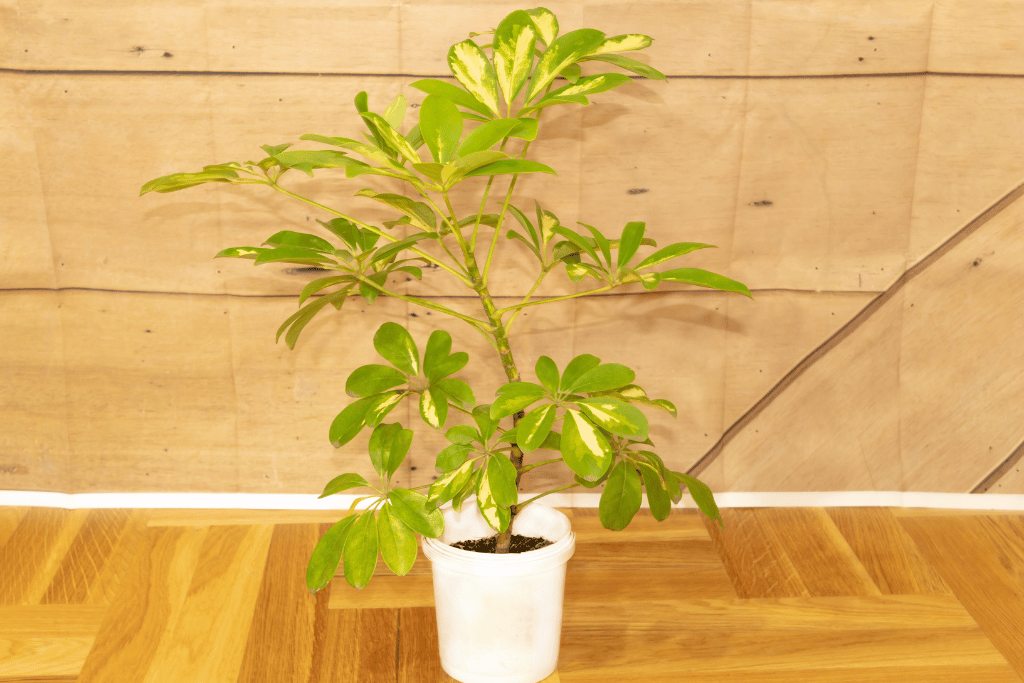
These plants stand out whether they are placed indoors or gracing your outdoor landscape. The unique arrangement of leaves resembling tiny umbrellas creates a charming visual appeal that’s hard to resist. And the best part? Taking care of these beauties isn’t as complex as it might seem. Let’s embark on the journey of nurturing your umbrella plants!
Types of Umbrella Plants

Umbrella plants, scientifically known as Schefflera, are popular indoor and outdoor plants cherished for their attractive foliage and ease of care. There are several different types of umbrella plants, each with its own unique characteristics. Here are some common types:
Dwarf Umbrella Plant (Schefflera arboricola):

The dwarf umbrella plant is well-suited for indoor spaces due to its compact size. It features smaller, glossy green leaves that grow in clusters of leaflets resembling tiny umbrellas. This variety is great for tabletops, shelves, or small corners.
Schefflera actinophylla:

Also known as the Queensland umbrella tree, this variety stands out with its larger and broader leaves that can grow up to 1 foot in length. Its leaves are deeply lobed, giving them an intricate appearance. This type of umbrella plant is often grown outdoors in tropical and subtropical regions.
Schefflera elegantissima:

Commonly called the false aralia, this umbrella plant variety boasts deeply serrated, variegated leaves. The leaves are a mix of green and creamy white, adding a touch of elegance to indoor spaces. It’s favored as a decorative plant and can thrive as a houseplant.
Schefflera taiwaniana:

This unique umbrella plant variety features a more compact growth habit and smaller leaves compared to its counterparts. The leaves have a distinct leathery texture and can display various shades of green. It’s a sought-after choice for collectors of exotic plants.
Schefflera rhododendrifolia:
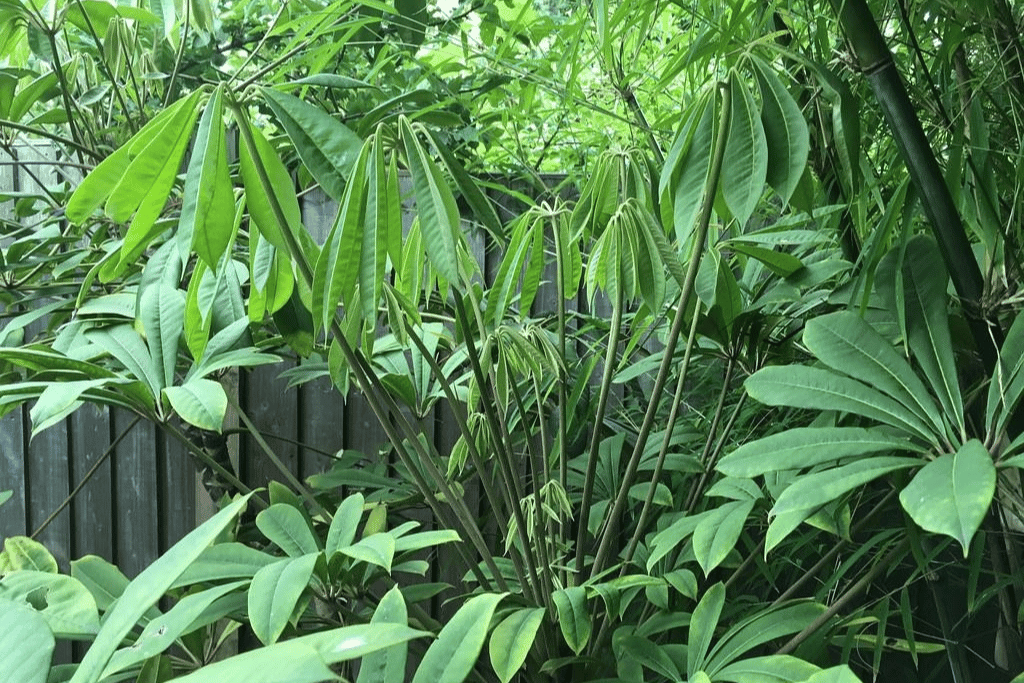
Native to Taiwan, this umbrella plant type stands out for its large, rhododendron-like leaves. The leaves have prominent veins and can grow quite sizable, making it an eye-catching addition to gardens in suitable climates.
Schefflera delavayi:

With a more tree-like growth pattern, this umbrella plant variety develops a sturdy trunk over time. Its glossy, dark green leaves have a unique shape and texture. This type is often chosen by those looking for a larger, statement plant for their living spaces.
Umbrella Plant Care – Environmental Requirements

Here’s how to care for umbrella plant! Keep in mind that the below information works for both umbrella plant care indoor and umbrella plant care outdoor!
Light
Umbrella Plants thrive in bright, indirect light!
Schefflera umbrella plant care involves positioning them near a window that receives filtered sunlight to keep them content. However, avoid exposing them to direct sunlight for extended periods, as it could lead to leaf scorching. A little light management can go a long way in ensuring their well-being.
Temperature
Maintaining the right temperature is akin to giving your umbrella plant a warm hug. Keep indoor temperatures in the range of 65-75°F (18-24°C) for optimal growth. Steer clear of drafty areas and extreme temperature fluctuations, as these plants prefer a stable, cozy environment.
Humidity
Umbrella Plants flourish in environments with moderate to high humidity. If your home tends to be on the drier side, worry not! Placing a water-filled tray near your plant or misting it occasionally can work wonders in elevating the humidity around your leafy companion.
Watering
Appropriate Watering Frequency Here’s the scoop: allow the top inch of soil to dry out before reaching for that watering can. Overwatering is a big no-no, so give your plant time to breathe between watering sessions. Adapt your watering routine based on the seasons and the humidity level of your space.
Watering Technique: When it’s time to water, give your umbrella plant a thorough soak. Ensure that water is distributed evenly throughout the soil, promoting healthy root development. Avoid letting your plant sit in standing water, as this could lead to unhappy, waterlogged roots.
Soil Requirements
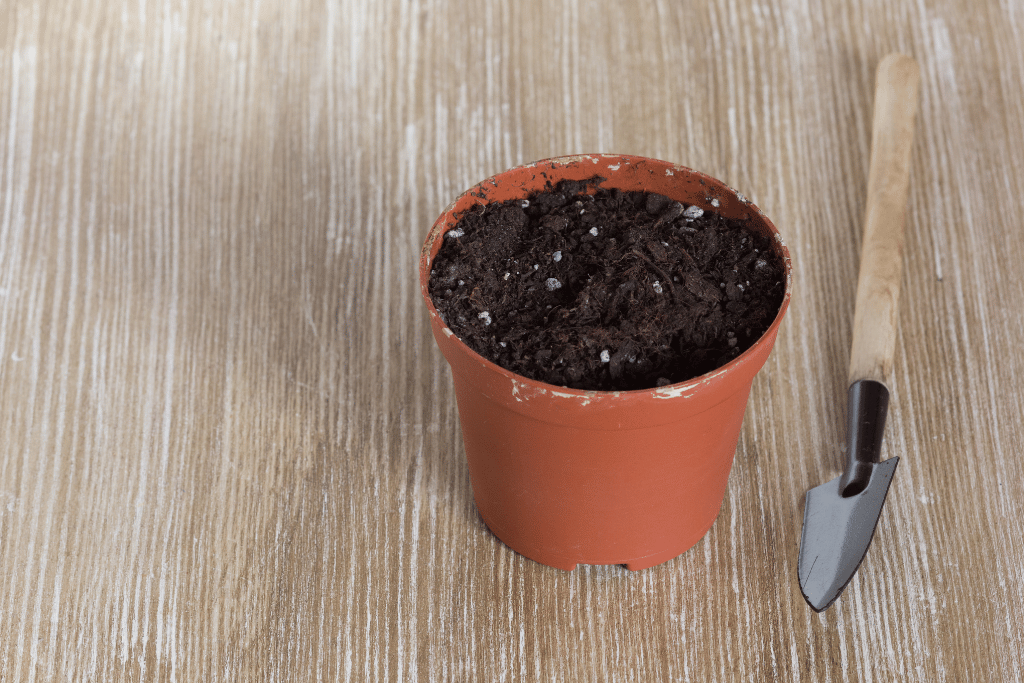
Your umbrella plant deserves a solid foundation, so opt for a well-draining potting mix. This type of mix prevents excess water retention, which can prevent root rot. You can enhance aeration by adding perlite or sand to the mix.
Repotting
Similar to us enjoying a change of scenery, your umbrella plant thrives when it’s repotted occasionally. If you notice it outgrowing its current home or the soil becoming depleted, treat it to a new pot and fresh soil. Think of it as a spa day for your beloved plant!
Container and Repotting
Selecting an Appropriate Container The size of the container matters, especially for your plant’s well-being. Opt for a pot slightly larger than its current one, providing ample room for growth. And don’t forget those drainage holes – they play a crucial role in preventing water buildup and potential root issues.
Repotting Schedule
Keep an eye out for signs that your umbrella plant is feeling cramped. When the roots start peeking through the drainage holes or the plant becomes top-heavy, it’s time for a change of home. Follow simple repotting steps to ensure a smooth transition without causing stress to your plant
Fertilization

Nutritional Needs
Umbrella Plants, like us, require their nutrients. Opt for balanced, water-soluble fertilizers that supply essential elements for growth.
Choosing the Right Fertilizer
Choosing the appropriate fertilizer is akin to treating your plant to a gourmet meal. During the active growth season, feed your plant every 4-6 weeks. Dilute the fertilizer according to instructions, as balance is key. Remember, moderation is crucial – excessive fertilization can lead to nutrient burn.
Pruning and Maintenance

Trimming for Size and Shape Control
When it comes to umbrella plant care pruning, guiding your umbrella plant’s growth is like tending to a canvas waiting to be painted. Prune to manage size and encourage bushiness. Trim overgrown or leggy branches to maintain a tidy appearance.
Removing Yellowing or Dead Leaves
Just as tidying up a space is essential, promptly remove yellowing or dead leaves. This practice not only enhances your plant’s aesthetics but also prevents potential pests from taking residence.
Pruning to Promote Branching
If you’re aiming for a fuller umbrella plant, proper pruning is key. Trim the growing tip of a stem to encourage branching, resulting in a more lush and compact plant.
Tools and Techniques for Effective Pruning
All you need are clean, sharp pruning shears and a steady hand. Trim just above a leaf node to avoid bare stems. Your umbrella plant will thank you for this rejuvenating session!
Propagation
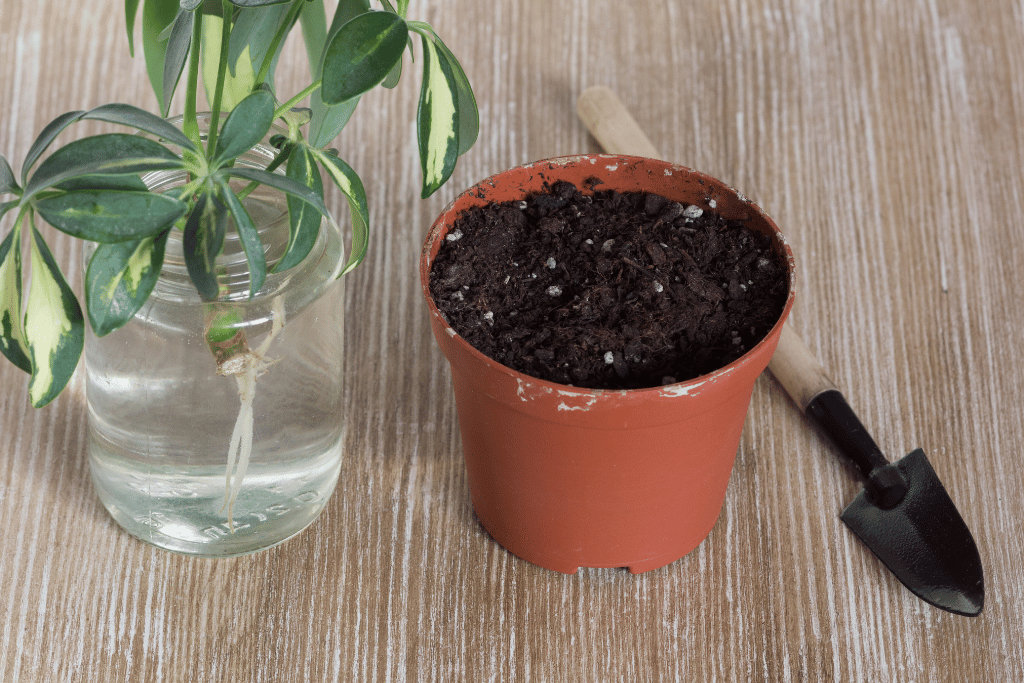
Propagation Methods
Interested in expanding your umbrella plant family? Count me in! Propagation is an exciting journey. You can propagate through stem cuttings in water or soil, or experiment with air layering for a unique approach.
Creating Optimal Conditions for Successful Propagation
Boost the chances of rooting by creating a mini greenhouse with high humidity around your cuttings. Maintain consistent moisture without over watering – think of it as a delicate balance to foster growth.
Transplanting Rooted Cuttings
Once your cuttings have established roots, it’s time for their new home. Plant them in a well-draining mix, water gently, and watch them flourish into independent plants.
Common Pests and Diseases
Identifying Common Pests
Uninvited guests, especially pests, can be quite bothersome. Keep an eye out for common troublemakers like spider mites and mealybugs. Regular inspections help you catch these pests early.
Recognizing Signs of Diseases
If your umbrella plant appears under the weather, it might exhibit signs of diseases like root rot or leaf spot. Keep an eye out for red flags like yellowing leaves or dark spots. Taking prompt action is essential for nursing your plant back to health.
Preventive Measures and Treatment Options
Creating a healthy environment is the best defense against pests and diseases. Prioritize proper hygiene, avoid overwatering, and ensure adequate air circulation. If issues arise, address them with natural remedies or mild insecticidal soap.
Seasonal Care
Adjusting Care Routines for Different Seasons
Just as our routines shift with the seasons, your plant’s care routine should adapt accordingly. During winter, when growth slows down, reduce watering and allow it to rest. In spring and summer, match the care to its growth spurts.
Monitoring and Adapting Care Based on Plant’s Responses
Your umbrella plant communicates its needs through leaves and growth patterns. Observe how it responds to your care routine and make adjustments as needed.
Troubleshooting
Analyzing Common Issues
Sometimes your umbrella plant might show signs of distress. Yellow leaves and drooping stems are indicators that something might be amiss.
Identifying Potential Causes and Solutions
No need to worry! Yellow leaves could point to overwatering or inadequate light. Drooping might result from underwatering or root issues. Identifying the issue is the first step towards resolving it.
Growing Umbrella Plants: Step-by-Step Process

Selecting a Healthy Plant or Starting from Cuttings
Begin your journey by selecting a healthy umbrella plant or embarking on the adventure of propagating from cuttings. Whichever path you choose, you’re in for a rewarding experience.
Providing the Right Environment
Light, temperature, and humidity – these elements are key to your plant’s happiness. Mastering these factors will contribute to your umbrella plant’s thriving.
Choosing the Appropriate Container and Potting Mix
Create a comfortable and spacious home for your plant. Opt for a pot that suits its size and use a well-draining potting mix for a strong start.
Watering and Fertilization Routine
Follow the golden rule of allowing the top inch of soil to dry before watering. Feed your plant with balanced, water-soluble fertilizer during the growing season for optimal health.
Pruning and Shaping for Desired Growth
Shape your plant’s growth through pruning and training. Whether you prefer a bushy or compact look, a little care goes a long way.
Monitoring for Pests, Diseases, and Prompt Response
Regularly check for pests, diseases, and signs of distress. Early intervention can protect your plant from potential harm.
Symptoms of a Struggling Umbrella Plant
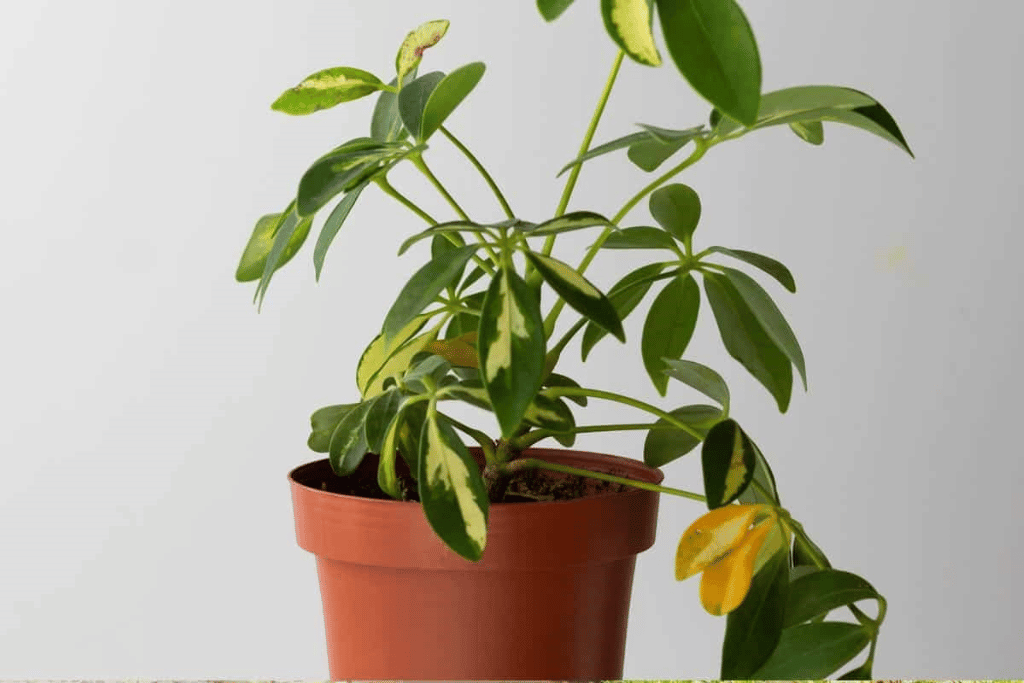
- Drooping and yellow leaves indicate potential stress or issues with care.
- Wilting and significant leaf loss suggest a need for care adjustments.
- Moldy or foul-smelling soil is a sign of overwatering, which can harm the roots.
- Lack of growth and new shoots could signal underlying challenges.
- Unusual discoloration, spots, or irregular growth might indicate pests or diseases.
Toxicity Considerations
- Umbrella plants contain calcium oxalate crystals, which can cause irritation if ingested.
- Keep these plants out of reach of curious pets and children, as consumption can lead to discomfort.
- Wear gloves when handling your umbrella plant and position it out of reach to ensure safety.
Dwarf and Variegated Umbrella Plant Care
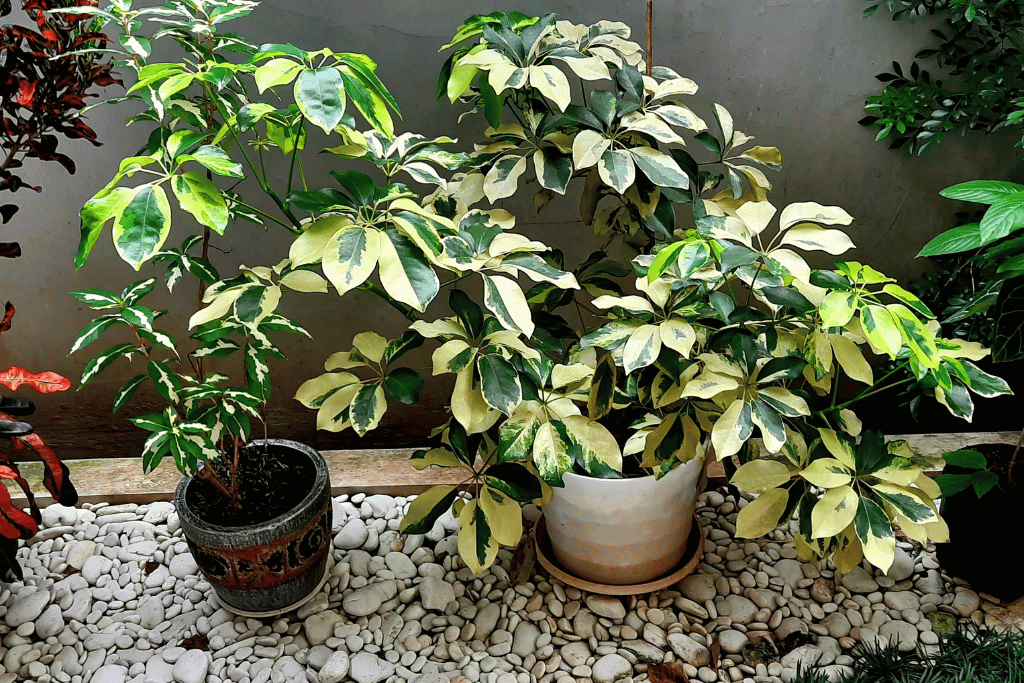
Dwarf umbrella plants and variegated umbrella plants are types of indoor houseplants. They are known for their distinctive umbrella-like leaf arrangement, which gives them their name. The main difference between these two lies in their size and leaf color patterns.
Dwarf Umbrella Plant Care and Variegated Umbrella Plant Care Involves the Same Steps!
Light Requirements: Both dwarf and variegated umbrella plants prefer bright, indirect light. Avoid placing them in direct sunlight, as it can scorch their leaves. They can thrive in areas with moderate light conditions.
Watering: Allow the top inch of the soil to dry out before watering. Overwatering can lead to root rot, so it’s important not to let the plant sit in waterlogged soil. Water moderately, and ensure good drainage.
Temperature: These plants do well in average room temperatures. Avoid exposing them to drastic temperature fluctuations and cold drafts.
Humidity: They prefer higher humidity, so occasionally misting their leaves or using a pebble tray can be beneficial, especially in dry indoor environments.
Soil: Use well-draining potting soil that retains some moisture but doesn’t become compacted. A mix formulated for tropical foliage plants is a good choice.
Fertilization: Feed with a balanced liquid fertilizer every 4-6 weeks during the growing season (spring and summer). Reduce or stop feeding in the fall and winter when growth slows down.
Pruning: Trim any yellowing or dead leaves to maintain the plant’s appearance and overall health.
Dwarf Vs. Variegated
Dwarf Umbrella Plant: As the name suggests, the dwarf umbrella plant is a smaller variety, making it suitable for compact spaces. Its leaves are typically green and not variegated, meaning they don’t have the distinct patterns of different colors.
Variegated Umbrella Plant: The variegated umbrella plant, on the other hand, features leaves with unique variegation. This means the leaves have patterns of different colors, often a mix of green and creamy white. The variegation adds to its visual appeal.
All in all, taking care of both dwarf and variegated umbrella plants involves providing them with the right amount of light, water, and humidity. Knowing the differences between these two types can help you choose the one that best suits your space and preferences.
Final Words
So, there you have it – a comprehensive guide on Umbrella plant care and growing. Keep an eye out on all the requirements mentioned above such as lighting and pruning. If you follow all the steps correctly, you’ll nurture your umbrella plants to their fullest potential.
Happy gardening, and may your umbrella plants bring lasting beauty to your surroundings!



